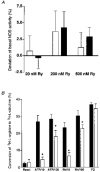Stealth ryanodine-sensitive Ca2+ release contributes to activity of capacitative Ca2+ entry and nitric oxide synthase in bovine endothelial cells
- PMID: 9806989
- PMCID: PMC2231284
- DOI: 10.1111/j.1469-7793.1998.369bb.x
Stealth ryanodine-sensitive Ca2+ release contributes to activity of capacitative Ca2+ entry and nitric oxide synthase in bovine endothelial cells
Abstract
1. The involvement of ryanodine-sensitive Ca2+ release (RsCR) in bradykinin (Bk)-induced Ca2+ release, capacitative Ca2+ entry (CCE) and nitric oxide synthase (NOS) activation was assessed in freshly isolated bovine coronary artery endothelial cells. 2. Using deconvolution microscopy fura-2 was found throughout the whole cytosol, while the cell membrane impermeable dye FFP-18 was exclusively in the cell membrane. Thus, perinuclear ([Ca2+]pn) and subplasmalemmal Ca2+ concentration ([Ca2+]sp) were monitored using fura-2 and FFP-18. 3. Inhibition of Na+-Ca2+ exchange by lowering extracellular Na+ concentration augmented the Bk-induced [Ca2+]pn signal in Ca2+-free solution. This effect was abolished when RsCR was prevented with 25 micromol l-1 ryanodine, while inhibition of RsCR had no effect on Bk-induced increase in [Ca2+]pn without inhibition of Na+-Ca2+ exchange. 4. Initiating RsCR by 200 nmol l-1 ryanodine increased [Ca2+]sp, while [Ca2+]pn remained constant. However, when Na+-Ca2+ exchange was prevented, ryanodine was also able to elevate [Ca2+]pn. 5. Blockage of RsCR diminished Ca2+ extrusion in response to stimulation with Bk in normal Na+-containing solution. 6. Inhibition of RsCR blunted Bk-activated CCE, while inhibition of Na+-Ca2+ exchange during stimulation enhanced CCE. 7. Although direct activation of RsCR failed to activate NOS, inhibition of RsCR diminished the effect of ATP and Bk on NOS, while the effect of thapsigargin remained unchanged. 8. These data suggest that during stimulation subplasmalemmal RsCR occurs, which contributes to the activities of CCE and NOS. Thus, the function of the subplasmalemmal Ca2+ control unit must be extended as a regulator for CCE and NOS.
Figures









Similar articles
-
Subplasmalemmal ryanodine-sensitive Ca2+ release contributes to Ca2+-dependent K+ channel activation in a human umbilical vein endothelial cell line.J Physiol. 2000 May 1;524 Pt 3(Pt 3):715-24. doi: 10.1111/j.1469-7793.2000.00715.x. J Physiol. 2000. PMID: 10790153 Free PMC article.
-
Mechanisms of Ca2+ store depletion in single endothelial cells in a Ca(2+)-free environment.Cell Calcium. 1999 May;25(5):345-53. doi: 10.1054/ceca.1999.0038. Cell Calcium. 1999. PMID: 10463098
-
Submaximal stimulation of porcine endothelial cells causes focal Ca2+ elevation beneath the cell membrane.J Physiol. 1998 Jan 1;506 ( Pt 1)(Pt 1):109-25. doi: 10.1111/j.1469-7793.1998.109bx.x. J Physiol. 1998. PMID: 9481676 Free PMC article.
-
Nitric oxide inhibits capacitative Ca2+ entry and enhances endoplasmic reticulum Ca2+ uptake in bovine vascular endothelial cells.J Physiol. 2002 Feb 15;539(Pt 1):77-91. doi: 10.1113/jphysiol.2001.013258. J Physiol. 2002. PMID: 11850503 Free PMC article.
-
Dual effects of insulin-like growth factor-I on the constitutive and inducible nitric oxide (NO) synthase-dependent formation of NO in vascular cells.J Endocrinol Invest. 1999;22(5 Suppl):82-8. J Endocrinol Invest. 1999. PMID: 10442576 Review.
Cited by
-
Subplasmalemmal ryanodine-sensitive Ca2+ release contributes to Ca2+-dependent K+ channel activation in a human umbilical vein endothelial cell line.J Physiol. 2000 May 1;524 Pt 3(Pt 3):715-24. doi: 10.1111/j.1469-7793.2000.00715.x. J Physiol. 2000. PMID: 10790153 Free PMC article.
-
Update on vascular endothelial Ca(2+) signalling: A tale of ion channels, pumps and transporters.World J Biol Chem. 2012 Jul 26;3(7):127-58. doi: 10.4331/wjbc.v3.i7.127. World J Biol Chem. 2012. PMID: 22905291 Free PMC article.
-
Na +/Ca2+ exchangers and Orai channels jointly refill endoplasmic reticulum (ER) Ca2+ via ER nanojunctions in vascular endothelial cells.Pflugers Arch. 2017 Oct;469(10):1287-1299. doi: 10.1007/s00424-017-1989-8. Epub 2017 May 11. Pflugers Arch. 2017. PMID: 28497275 Free PMC article.
-
Anandamide initiates Ca(2+) signaling via CB2 receptor linked to phospholipase C in calf pulmonary endothelial cells.Br J Pharmacol. 2003 Dec;140(8):1351-62. doi: 10.1038/sj.bjp.0705529. Epub 2003 Nov 24. Br J Pharmacol. 2003. PMID: 14645143 Free PMC article.
-
Uncoupling protein 3 adjusts mitochondrial Ca(2+) uptake to high and low Ca(2+) signals.Cell Calcium. 2010 Nov;48(5):288-301. doi: 10.1016/j.ceca.2010.10.004. Epub 2010 Nov 2. Cell Calcium. 2010. PMID: 21047682 Free PMC article.
References
-
- Busse R, Fichter H, Lückhoff A, Kohlhardt M. Hyperpolarization and increased free calcium in acetylcholine-stimulated endothelial cell. American Journal of Physiology. 1988;255:H965–969. - PubMed
-
- Colden-Stanfield M, Schilling WP, Ritchie AK, Eskin SG, Navarro LT, Kunze DL. Bradykinin-induced increases in cytosolic free calcium and ionic currents in bovine aortic endothelial cells. Circulation Research. 1987;61:632–640. - PubMed
-
- Corda S, Spurgeon HA, Lakatta EG, Capogrossi MC, Ziegelstein R. Endoplasmic reticulum Ca2+ depletion unmasks a caffeine-induced Ca2+ influx in human aortic endothelial cells. Circulation Research. 1995;77:927–935. - PubMed
-
- Davies EV, Hallett MB. Near membrane Ca2+ changes resulting from store release in neutrophils: detection by FFP-18. Cell Calcium. 1996;19:355–362. 10.1016/S0143-4160(96)90076-7. - DOI - PubMed
Publication types
MeSH terms
Substances
LinkOut - more resources
Full Text Sources
Miscellaneous

